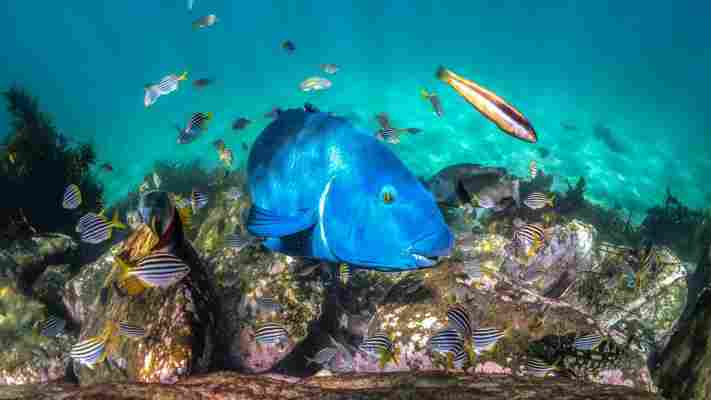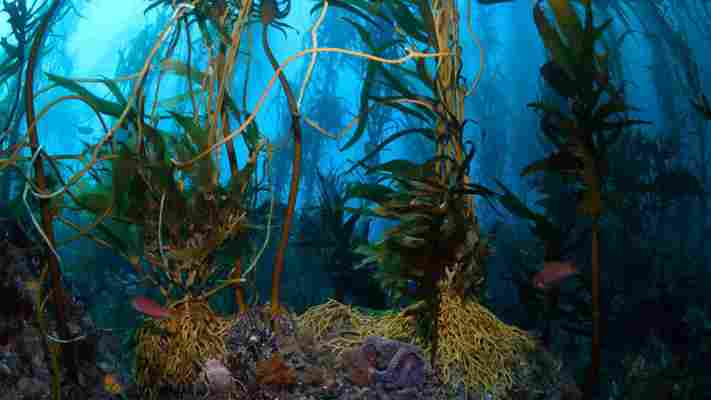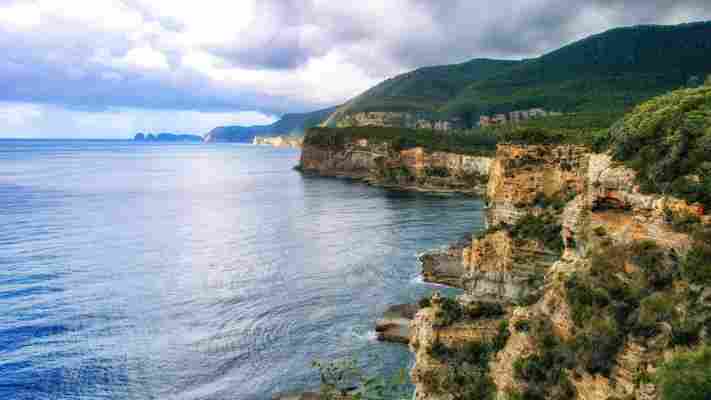“Imagine flying through an old-growth forest,” said Mick Baron, owner of Eaglehawk Dive Centre in south-eastern Tasmania, when I asked the scuba-diving veteran what it was like to swim among the majestic giant kelp forests that once fringed Australia’s island state.

“Whether you’re cruising along the bottom looking up as the sun glints through the canopy or hanging out just below the surface peering down the trunks of these giant trees, so to speak, it was pretty special,” said Baron, wistfully. “There was marine life to see, too, but the star attraction was the kelp.”

Tasmania was once surrounded by giant kelp forests – but only 5% are left (Credit: Nigel Marsh/Getty Images)
Listed as an endangered ecological community by the Australian government in 2012, Tasmania’s giant kelp forests are more than 95% gone, with a spike in ocean temperatures triggered by the 2015-16 El Niño event speeding up a gradual die-off that had been occurring over several decades.
“In the space of about three months those big beds of forests had gone,” said Baron. “And I mean gone . There wasn’t a skerrick left. And they haven’t come back.”
Australia’s forgotten reef
Tasmania’s giant kelp forests formed part of what’s known as the Great Southern Reef , a vast system of temperate rocky reefs stretching some 8,000km from Kalbarri in Western Australia, down and around Australia’s rugged southern coast and Tasmania and up into northern New South Wales.
Despite 70% of Australia’s population living within 50km of the Great Southern Reef, most people have never heard of it. To be fair, this unique marine environment didn’t even have a name until 2016, when a team of scientists led by University of Western Australia (UWA) marine biologists Scott Bennett and Thomas Wernberg argued that this was part of its identity problem.

The Great Southern Reef stretches some 8,000km around Australia’s southern shores, including Tasmania’s rocky coastline (Credit: Atosan/Getty Images)
Dominated by kelp forests that sustain life in this biodiversity hotspot, the Great Southern Reef is home to hundreds of species not found anywhere else on Earth (including all three known seadragon species, seahorse-like creatures that look just as mystical as they sound), with an estimated 10,000 additional species yet to be identified. The reef also props up fishing and tourism industries worth approximately $10bn to the Australian economy, with its lucrative southern rock lobster and abalone industries alone worth four times the value of commercial fishing activities on the Great Barrier Reef.
But while most scientists agree the Great Southern Reef is in better general health than its northern counterpart, climate change is an increasing threat. While rising ocean temperatures have led to devastating coral bleaching events on the Great Barrier Reef, it’s kelp that suffers when ocean temperatures increase further south. And just as marine scientists are trying to save the Great Barrier Reef with technologies ranging from “ coral IVF ” to the development of a heat-resistant micro-algae , scientists around the Great Southern Reef are also trialling methods to protect its foundation species.
Super kelp to the rescue?
In Hobart, a joint research project between the University of Tasmania’s Institute of Marine and Antarctic Studies (IMAS) and the Climate Foundation is currently studying the possibility of restoring Tasmania’s giant kelp forests, whose demise is attributed to the increased influence of the East Australian Current (EAC), which is bringing warmer, nutrient-poor water down to Tasmania – and unwanted hitchhikers with it.
“Not only is kelp particularly sensitive to water temperature changes, but also to tropical marine species that feed on algae, and kelp is a type of algae,” explained IMAS postdoctoral research fellow and co-project lead Dr Cayne Layton.
The Great Southern Reef is home to hundreds of unique species, including the leafy sea dragon (Credit: Alastair Pollock Photography/Getty Images)
In Tasmania, the long-spined sea urchin has wreaked havoc on giant kelp, turning lush underwater forests into what Layton describes as “veritable deserts”. But there’s hope, with IMAS scientists developing a “super kelp” that could help to save the species – or at least buy it a few more decades, if the urchins can be kept at bay.
“We’ve taken samples from remaining patches of giant kelp and tested them in a variety of water temperatures,” explained Layton. “We breed the ones that do best in high temperatures, which we call ‘super kelp’, then plant those out.”
Following signs of success from planting methods trialled in late 2019, scientists are currently preparing to plant out the project’s second culture of super kelp.
“It’s baby steps, but I’m hopeful that we’ll get these patches going and they’ll be self-sustaining,” said Layton. “The real tipping point will be if they can self-expand.”
70% of Australia’s population lives within 50km of the Great Southern Reef (Credit: RugliG/Getty Images)
Citizen science is also playing a role in the project, with IMAS scientists urging the public to record sightings of giant kelp, which form a buoyant canopy, via the free Kelp Tracker app launched late last year. Despite a reduction in app use during coronavirus shutdowns, Layton said logged sightings have already helped scientists to identify remnant colonies they weren’t aware of.
Northern exposure
It’s not just the Great Southern Reef’s giant kelp forests that are in danger, however, with common (also known as golden) kelp forests also making a retreat down the coastlines of Western Australia and New South Wales. This phenomenon is being closely monitored by marine scientist and UWA PhD candidate Sahira Bell, whose field work is largely focused in Kalbarri, 570km north of Perth.
You may also be interested in: • Can science and tourism save the reef? • The voyage that birthed oceanography • Is this Australia's best-kept secret?
“Many temperate marine species are already living at their thermal maximums around Kalbarri, so when we get climatic changes, we tend to see them here first,” Bell explained. Triggered by a 2011 marine heatwave, the biggest change saw common kelp forests retract 100km south from Kalbarri within a matter of weeks. Similarly to Tasmania’s giant kelp forests, they haven’t returned.
“The aquatic landscape in Kalbarri is now what we call turf – an algae similar to grass on land,” said Bell. “There’s still some fish and coral, but it is essentially a collapse in habitat.”
The Great Southern Reef is in better health than the more-famous Great Barrier Reef to the north (Credit: RugliG/Getty Images)
Australia’s south-east coast is less prone to heatwaves, Bell said, yet its common kelp forests are also in retreat, with herbivorous fish partial to the kelp forests in the Coffs Harbour area on New South Wales’ north coast.
Many people think coral only grows in the tropics, but we get beautiful cold-water corals on the Great Southern Reef
Unsurprisingly, the Great Southern Reef’s kelp decline has not been good for business, either for marine tourism operators like Baron forced to adjust their offerings, or for commercial and Indigenous fisheries dependent on healthy marine stocks. Last year, the Tasmanian government committed A$5.1m to tackle its urchin threat, but it’s spare change in comparison to conservation funding directed to the Great Barrier Reef, let alone the A$233million pledged to boost post-coronavirus tourism in Australia’s national parks.
“No-one is questioning the value or the purpose of forests on land, but kelp forests have the same function – they just happen to be a bit wetter,” Layton said. “But for most people they’re out of sight, out of mind.”
Driving awareness
According to marine scientists, the key to protecting the Great Southern Reef and its kelp forests is creating awareness of its very existence. Among its most successful ambassadors, Bell campaigned for the reef to be recognised as a Hope Spot by international marine non-profit Mission Blue, headed by renowned US marine biologist Dr Sylvia Earle, last December.
Australian sea lions are an icon of the Great Southern Reef (Credit: Stephen Frink/Getty Images)
“Hope Spots are regions of the ocean that are critical to ocean health but are underacknowledged and under-protected, and that’s exactly what the Great Southern Reef is,” said Bell, who was thrilled by the public reaction to the Hope Spot listing. “Even Australians have been saying: ‘The Great Southern Reef is amazing, I never knew it was there’,” she said.
Over in Victoria, marine scientist and director of Deakin University’s Bachelor of Marine Science course Dr Prue Francis is working to create awareness among younger generations in the form of a children’s book that is due to be published in 2021.
“Being a marine scientist and a mum, I’d look for the ocean books in the bookstore to read to my kids, and I was noticing that that a lot of books were based on tropical environments, with almost nothing on the Great Southern Reef,” Francis explained.
Teaming up with a writer and an illustrator from Deakin, Francis’ book, provisionally titled Professor Seaweed and the Great Southern Reef, is designed to help children identify marine curiosities they may find on beaches bordering the Great Southern Reef with the help of characters like Professor Seaweed, a marine scientist, and a mother with a penchant for beachcombing.
The Great Southern Reef has been successfully recognised as a Hope Spot (Credit: Alberto Mazza/Getty Images)
“Many species that live on the Great Southern Reef are endemic, so if we were to look at images of seaweed or shark eggs in children’s books from the US or the UK, we can’t relate to those images,” Francis said. The book offers a hint as to why even so few Australian are aware of what lies beyond their local beach.
We’re on a mission to raise awareness of how pristine, valuable and important these reefs are
“The Great Southern Reef hasn’t shifted towards the tourism sector quite like the Great Barrier Reef has, and that’s mostly due to the water being so cold,” Francis explained.
There’s also a misconception, say scientists, that cool water marine habitats aren’t as colourful or as interesting as their tropical counterparts.
“Many people think coral only grows in the tropics, but we get beautiful cold-water corals on the Great Southern Reef,” Bell countered. “The sponge gardens are also incredible – they can even be more colourful than a tropical coral reef.”
And while there are myriad ways to experience the Great Southern Reef, from snorkelling amid swarms of frisky giant cuttlefish off the beaches of South Australia to scuba diving alongside playful New Zealand fur seals in Tasmania, you don’t even need to get wet to appreciate it, with several permanent webcams near Melbourne offering an online window into this mysterious marine ecosystem.
Every winter, thousands of giant Australian cuttlefish congregate off South Australia’s shores to breed (Credit: by wildestanimal/Getty Images)
In Port Philip Bay, the Nature Conservancy Australia’s Reef Cam beams live footage from cameras fixed above and below the water, where you might spot an Australian fur seal corkscrewing through the kelp. You can also virtually peep into a little penguin burrow on Phillip Island to see if any of the world’s smallest penguins are nesting.
A Great Southern Reef feature documentary is also on the way, thanks to Australian marine biologist–turned filmmaker Stefan Andrews, whose aquatic filming credits include BBC Earth’s Blue Planet II and the Netflix hit Chasing Coral.
“We’re on a mission to raise awareness of how pristine, valuable and important these reefs are, and help to embed the concept of the Great Southern Reef in Aussie culture,” Andrews said.
The largest populations of fairy penguins are found on Phillip Island, south of Melbourne (Credit: 4FR/Getty Images)
The World of Tomorrow is a BBC Travel series that visits ingenious communities around the world that are adapting to environmental change or who are finding new ways to live sustainably.
Join more than three million BBC Travel fans by liking us on Facebook , or follow us on Twitter and Instagram .
If you liked this story, sign up for the weekly bbc.com features newsletter called "The Essential List". A handpicked selection of stories from BBC Future, Culture, Worklife and Travel, delivered to your inbox every Friday.
